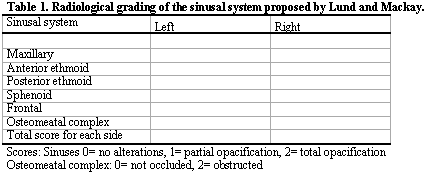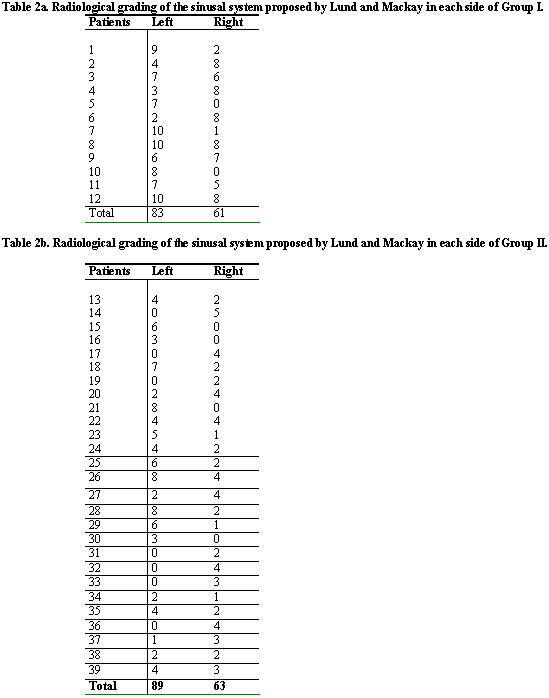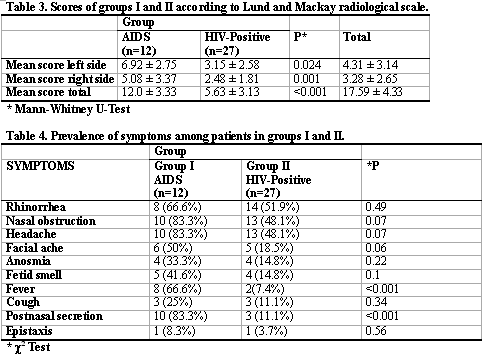

Year: 2005 Vol. 71 Ed. 5 - (9º)
Artigo Original
Pages: 604 to 608
Chronic rhinosinusitis in HIV-infected patients: radiological and clinical evaluation
Author(s): Ivan Dieb Miziara1, Bernardo Cunha Araujo Filho2, Rodrigo Cataldo de La Cortina3, Fabrício R. Romano4, Adriana S. Lima5
Keywords: rhinosinusitis, HIV, AIDS, tomography computerized.
Abstract:
The advent of the proteases inhibitors caused one better quality of life to the HIV-infected patients, increasing the search for ENT doctors, because 40 to 70% of these patients present with main complaint, symptom or physical finding in the head and neck. Aim: The objectives are compare the CT Scan findings and nasosinusal complains, correlating with the levels of CD4+ among HIV infected and AIDS patients, with clinical diagnosis of chronic rhinosinusitis. The literature on the subject is revised and discussed. Study design: clinical prospective with transversal cohort. Material and Methods: Prospectively, 39 patients with chronic rhinosinusitis, in use of antiretroviral therapy were included in the present study. These were divided in two groups: patient just infected by HIV (group II) and those with the diagnosis of AIDS (group I). Clinical assessment, laboratorial evaluation, with counting of cells CD4+, and evaluation CT scan were performed and compared among group I and II. Results: The patients of the group I and II presented mean counting of cells CD4+: 118 cel/10-9 l and 377 cel/ 10-9 l, respectively. In the comparison of the radiological findings (the Lund-Mackay staging system), the group I presented score of 12. The second group (group II) presented score of 5,63 (p£0,001). Fever and postnasal discharge were more prevalent in group I (p£0,001). Conclusions: The prevalence of the chronic rhinosinusitis in the HIV infected patients in our ENT department was 12%. The patients with AIDS presented more fever and postnasal discharge than the patients of the group II. Besides, the patients with AIDS presented more extended radiological findings than the patients of group II.
![]()
Introduction
The human immunodeficiency virus (HIV) has been widely studied and researched in the last two decades. The advent of protease inhibitors, which improves survival and quality of life of patients, has increased the number of asymptomatic HIV-infected individuals worldwide1,2. As a consequence, many of these patients have visited otorhinolaryngologists, since 40-70% of them may present some sort of otorhinolaryngological disorder2,3.
Chronic rhinosinusitis is the most common affection among HIV-infected patients, particularly those with advanced immunosuppression 1,4. Prevalence of this disease in these individuals varied from 10% to 68%, as reported in the literature1,2,4,5.
On the other hand, rate of lymphocyte population, specifically CD4+ lymphocytes, is considered a useful mean to assess the immunological response, which is directly related to severity and chronicity of rhinosinusitis of patients with low levels of CD4+ T lymphocytes4.
In order to assess patients with chronic rhinosinusitis, anamnesis plus radiological and endoscopic procedures are necessary. Computerized tomography of the paranasal sinuses yields a focused evaluation, as it quantifies extension of the sinunasal process. Lund-Mackay radiological classification system for rhinosinusitis is an easy and objective method in routine clinical practice6.
Our goal is to compare tomographic findings with the nasosinusal symptomatology among HIV-positive patients (with or without AIDS) with clinical diagnosis of chronic rhinosinusitis. The literature is also revised and discussed.
Material and Methods
The Otorhinolaryngology Ambulatory of Hospital das Clínicas, Medical School, University of Sao Paulo (HCFMUSP) admitted 314 seropositive patients with acquired immunodeficiency syndrome and general otorhinolaryngological complaints from July 1995 to November 2002. Prospectively, out of these patients, 39 presented chronic rhinosinusitis and were non-responsive to routine clinical treatments. All patients were receiving antiretroviral therapy and had been previously treated with oral antibiotics for sinusitis by their general practitioners.
Patients were submitted to anamnesis and complete otorhinolaryngological exam. Laboratorial assessment with CD4+ cell count was performed at first consultation. Computerized tomography (CT) of paranasal sinuses was performed at axial and coronal sections a week after the first consultation. Extension and severity of rhinosinusitis were radiologically graded according to Lund and Mackay criteria, suggested by the rhinosinusitis taskforce of the American Academy of Otorhinolaryngology6 (Table 1).
Patients were divided into two groups, according to presence of AIDS (group I, n=12) or HIV-infection only (group II, n=27), following the CDC criteria (1993) 7. Averages of CD4+ cells were compared in both groups. In addition, the most prevalent nasosinusal symptoms were also compared, while the tomographic findings were graded by Lund and Mackay system.
All data collected were statistically analyzed according to chi-square test (Fisher's precise test) and to Mann-Whitney U-Test.
All patients signed an informed consent term to participate in the study, which was approved by the Committee of Ethics of the Division of Clinical Otorhinolaryngology, HCFMUSP.
Results
The prevalence of chronic rhinosinusitis in our series was of 12% - 39 patients non-responsive to routine clinical treatment among 314 seropositive patients with general otorhinolaryngological complaints.
Out of 39 selected patients, 12 (31%) were diagnosed with AIDS and the others (27) were HIV-infected only. Age ranged from 5 to 62 years, mean of 32. Thirty-one individuals were men (79.4%).
The most frequent cause of HIV transmission was sexual intercourse (65.5%), followed by intravenous drug use (17.2%), blood transfusion (10.3%) and vertical transmission (7%).
Group I patients had an average CD4+ cell count of 118 / 10-9l, while group II presented an average of 377 cells/ 10-9l. The difference was statistically significant (p< 0.005).
Comparison of tomographic findings (Tables 2a, 2b and 3) demonstrated that group I patients presented a mean score of 12 (standard deviation: 3.33), while group II was of 5.63 (standard deviation: 3.13). A significantly statistical difference was observed between both groups (p< 0.001). Presence of a pansinusal mucous layer was observed in all images of group I patients. Presence of pansinusal opacification was observed in 4 patients of group I, all presenting CD4+ levels below 80 cells/ 10-9l. The maxillary sinus was prevalently the most affected. All patients had tomographic alterations of the maxillary sinus (100%).
Assessment of nasosinusal symptoms among the groups (Table 4) showed significant differences only for fever and postnasal secretion (p<0.001).
Discussion
Chronic rhinosinusitis has been reported as a common disease in HIV-infected patients4,5. However, its prevalence has shown to be varied in many studies, which is probably due to different methods and methodologies used to diagnose rhinosinusitis4,8. Garcia-Rodrigues et al.4 reported a prevalence of 35%, taking into account the clinical symptomatology, endoscopic exam and computerized tomography in the diagnosis of rhinosinusitis. Tarp et al.8, using magnetic resonance imaging, observed a prevalence of 54.3%. Porter et al.1 presented 70% prevalence as a result of a survey on nasosinusal symptoms. In our study, we found a prevalence of 12% among 314 seropositive patients with general otorhinolaryngological complaints who were referred to our otorhinolaryngology ambulatory. The low prevalence (12%) of these complaints in our case series may be due to the fact that acute conditions were initially treated by infectologists or general physicians, and only the patients who were not responsive to initial treatment were referred to us.
Regarding the symptomatology, our patients presented the same signs and symptoms in both groups (with and without AIDS), similarly to the population in general. The most common findings were purulent rhinorrhea, nasal obstruction and headache, respectively, which is in accordance with Zurlo et al.9.
Porter et al.1, when comparing seropositive patients - with or without AIDS -, also concluded that the symptoms and severity of rhinosinusitis were similar in both groups. However, we observed in our study that, from radiologically analyses, rhinosinusitis was more severe in AIDS patients, who presented extensive nasosinusal disease.
Our findings are consistent with those of Tarp et al.8, whose study infers that AIDS patients have more significant pathological alterations than HIV-infected individuals. In addition, our study agrees with Small et al.10, which compared groups of seropositive patients and AIDS patients, observing higher IgE levels in the latter. In fact, they attribute to atopy and allergic reaction the base of rhinosinusitis development in these patients10.
Relative to AIDS, fever had high incidence in our study (66.6%) (Table 4), which in immunodepressive patients may sign an unspecific response to the presence of infection, justifying its great significance. Differently, posterior rhinorrhea can be indicative of higher severity of the disease in AIDS patients.
Difference in CD4+ cell count in both groups was statistically significant. Average levels observed in both groups were lower than 200 cells/10-9l, indicating highly severe immunosuppression, as well as greater proneness to chronification and severe rhinosinusitis3,4,11,12. Inversely, in Porter et al.1 and Tarp et al.8 studies, CD4+ levels were not significantly lower in patients with great nasosinusal alterations.
Regarding the radiological findings, the use of Lund-Mackay system demonstrated practical application and adequate interpretation power, as suggested by its precursors6. AIDS patients presented higher average score of paranasal sinus affection than HIV-infected individuals.
Concomitantly, it is important to emphasize that the CD4+ levels observed reveal a predictive tendency to larger tomographic alterations proportionally to the immunosuppression grade, although this study's casuistic may have limited significance due to the reduced number of patients. However, suspicion is based on the tomographic findings, which reveal larger pansinusal mucous layer in patients of group I. The other four patients with pansinusal opacification presented CD4+ levels below 80 cells/ 10-9l. These data are in accordance with those reported by Godofsky et al.13 , who previously demonstrated an inverse relation between CD4+ cell count and number of affected sinuses.
Involvement of maxillary sinuses is common among HIV-infected population with rhinosinusitis2,4,8,14-16. In our series, the most affected sinus in both groups was the maxillary sinus (100%).
Tarp et al.8 used magnetic resonance to diagnose rhinosinusitis in HIV-infected patients, disregarding the clinical diagnosis. For some authors, tomography is a secondary exam in infected patients, which is performed only in cases where the endoscopic exam proved to be ineffective to diagnose rhinosinusitis4. However, chronic rhinosinusitis in some cases may be "silent", with no symptoms, but presenting important radiological alterations in the computerized tomography6,13 . Moreover, in our study, similarity of symptoms was also observed in both groups. Therefore, we partially disagree with these authors, as we believe that imaging provides us with essential information concerning nasosinusal disease and its intensity in immunodepressed patients.
Finally, we believe that tomography is an extremely important exam in the assessment of positive HIV-patients, particularly in those with low levels of T CD4+ lymphocytes, which present higher severity of nasosinusal disease. Moreover, this exam is useful both to exclude fungi infection and to improve presurgical plan, which was verified in our study and of other authors6,13,17. In our opinion, the use of radiological methods associated with anamnesis and nasofibroscopy would be a good choice in daily clinical practice.
Conclusion
* Prevalence of chronic rhinosinusitis in HIV-infected patients referred to our otorhinolaryngology ambulatory was of 12%.
* Incidence of fever and posterior rhinorrhea was statistically higher in AIDS patients (group I) than in seropositive ones (group II).
* AIDS patients presented more extensive nasosinusal alterations in computerized tomography assessment than HIV-positive patients.
References
1. Porter JP, Patel AA, Dewey CM, Stewart MG. Prevalence of Sinonasal Symptoms in Patients with HIV Infection. Am J Rhinol 1999; 13(3): 203-8.
2. Murphy C, Davidson TM, Jellison W, Austin S, et al. Sinonasal Disease and Olfactory Impairment in HIV Disease: Endoscopic Sinus Surgery and Outcome Measures. The Laryngoscope 2000; 110 (Oct): 1707-10.
3. Belafsky PC, Amedee R, Moore B, Kissinger PJ. The Association Between Sinusitis and Survival Among Individuals Infected with the Human Immunodeficiency Virus. American Journal of Rhinology 2001; 15 (5): 343-5.
4. Garcia-Rodriguez JF, Corominas M, Fernandez-Viladrich P, Monfort JL, Dicenta M. Rhinosinusitis and Atopy in Patients Infected with HIV. The Laryngoscope 1999; 109(6): 939-44.
5. Tami TA. The Management of Sinusitis in Patients Infected with the Human Immunodeficiency Virus (HIV). Ear Nose Throat J 1995; 74(5): 360-3.
6. Lund V, Kenndy DW. Staging for Rhinosinusitis. Otolaryngology-Head and Neck Surgery 1997; 117(3pt 2): 35-40.
7. Hudeleringh RJ. Recurrent maxillary sinusitis on AIDS patients. In: Proceedings of the Ivth International Conference on AIDS. The Scientific and Social Challenge. Abstracts. International Development Research Center, Ottawa 1989; p.255.
8. Tarp B, Fiirgaard B, Moller J, Hilberg O, et al. The Occurrence of Sinusitis in HIV-Infected Patients with Fever. Rhinology 2001; 39: 136-41.
9. Zurlo JJ, Feuerstein IM, Lebovics R, Lane HC. Sinusitis in HIV-1 Infection. Am J Med 1992; 93(2): 157-62.
10. Small CB, Kaufman A, Armenaka M, Rosenstreich DL. Sinusitis and Atopy in Human Immunodeficiency Virus Infection. The Journal of Infectious Disease 1993; 167: 283-90.
11. Meiteles LZ, Lucente FE. Sinus and Manifestations of the Acquired Immunodeficiency Syndrome. Ear, Nose and Throat 1990; 69: 454-9.
12. Upadhyay S, Marks SC, Arden RL, Crane LR, Cohn AM. Bacteriology of Sinusitis in Human Immunodeficiency Virus-Positive Patients: Implications for Management. Laryngoscope 1995; 105 (10): 1058-60.
13. Godofsky EW, Zinreich J, Armstrong M, Leslie JM, Weikel CS. Sinusitis in HIV-Infected Patients: A Clinical and Radiographic Review. Am J Med 1992; 93(2): 163-70.
14. Rubin JS, Honinberg R. Sinusitis in Patients with the acquired immunodeficiency syndrome. Ear, Nose and Throat Journal 1990; 69: 460-63.
15. Mofenson LM, Korelitz J, Pelton S, Moye J Jr, Nugent R, Bethel J. Sinusitis in Children Infected with Human Immunodeficiency Virus: Clinical Characteristics, Risk Factors, and Prophylaxis. National Institute of Child Health and Human Development Intravenous Immunoglobulin Clinical Trial Study Group. Clin Infect Dis 1995; 21(5): 1175-81.
16. Stuck M, Hachler I, Luthy R, Ruef C. Sinusitis in HIV Infection. Dtsch Med Wochenschr 1994; 119(51-52): 1759-65.
17. Spech TJ, Rehm, SJ, Longworth DL, Keys TF, McHenry MC. Frequency of sinusitis in AIDS patients. In: Proceedings of the IVth International Conference on AIDS. 1988: Stockhol International Affairs, Stockholm; Abstract 7.088.
Ph.D. in Otorhinolaryngology, Medical School, USP, Technical Director of Health Center.
Otorhinolaryngologist, Specialist of Otorhinolaryngology, SBORL, Ph.D. studies under course, Division of Clinical Otorhinolaryngology, FMUSP.
Ph.D., FMUSP, Otorhinolaryngologist.
Ph.D., FMUSP, Otorhinolaryngologist..
Ph.D., FMUSP, Otorhinolaryngologist..
Study carried out the Division of Clinical Otorhinolaryngology, Department of Otorhinolaryngology and Ophthalmology, Medical School, University of Sao Paulo.
Address correspondence to: Bernardo Cunha Araujo Filho - Rua Oscar Freire 1799 ap. 302 Pinheiros Sao Paulo SP 05403-009.
Tel: (55 11) 8319-4444 - E-mail: bcaf@terra.com.br
The present article was submitted through SGP on 8/Mar/2005 and approved on 16/Sept/2005.


